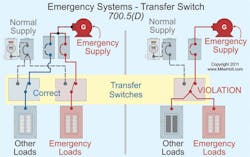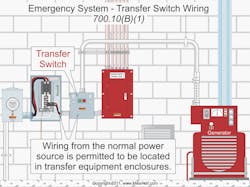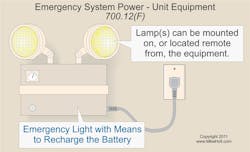Emergency systems are the circuits and equipment that supply illumination, power, or both within 10 sec [700.12] after interruption of the normal electrical supply [700.1] (Fig. 1). The requirements for the installation, operation, and maintenance of these systems are found in Art. 700.
One use of emergency systems is to provide lighting for safely evacuating buildings that large numbers of people occupy (e.g., hospitals and sports arenas). These systems may also provide power to maintain life, fire detection and alarm systems, elevators, fire pumps, and public safety communications systems. They may even provide power to industrial processes to prevent the serious life safety or health hazards that would result from loss of power. But don’t confuse emergency systems with standby systems (see SIDEBAR: Standby Versus Emergency).
Testing and maintenance
To ensure the emergency system meets or exceeds the original specifications, the AHJ must conduct or witness an acceptance test of the system after installation and before turnover to operations [700.3]. The initial testing also establishes baseline data for maintenance of the system and its components.
The NEC requires periodic testing for maintenance. By “periodic,” the NEC means doing the testing at intervals recommended by the applicable standards, industry norms, and manufacturer literature. The AHJ refers to these to determine if the testing frequency is adequate.
Load shedding
The emergency system must be able to supply all emergency loads simultaneously [700.4(A)]. If an alternate power supply has adequate capacity, it may supply emergency loads [Art. 700], legally required standby loads [Art. 701], and optional standby system loads [Art. 702]. When the emergency supply also supplies power for nonemergency loads, the emergency loads take priority. If it doesn’t have adequate capacity to carry all loads, it must have automatic selective load pickup and load shedding to ensure adequate power in this order of priority [700.12(B)]:
1) Emergency circuits
2) Legally required standby circuits
3) Optional standby circuits
A temporary alternate source of power must be available whenever the emergency generator is out of service for more than a few hours for maintenance or repair.
Transfer equipment
Transfer equipment must be automatic, identified for emergency use, and approved by the AHJ [700.5 (A)]. It must supply only emergency loads (Fig. 2). Automatic transfer switches must be electrically operated, mechanically held, and listed for emergency system use. You must use multiple transfer switches where a single generator supplies emergency loads plus other loads.
Wiring
At the service-entrance equipment, place a sign indicating the type and location of on-site emergency power sources [700.7]. Permanently mark the system’s boxes and enclosures as components of an emergency system [700.10(A)]. That requirement includes transfer switches, generators, and power panels for emergency circuits.
To ensure that a fault on the normal wiring circuits won’t affect the performance of emergency wiring or equipment, keep all wiring to emergency loads independent of all other wiring. These exceptions apply to:
• Wiring in transfer equipment (Fig. 3).
• Luminaires supplied from two sources of power.
• A junction box attached to luminaires supplied from two sources of power.
• Wiring within a common junction box attached to unit equipment, containing only the branch circuit supplying the unit equipment and the emergency circuit supplied by the unit equipment.
Wiring from an emergency source can supply any combination of emergency, legally required, or optional standby loads — but only under one of these conditions [710(B)(5)]:
• It’s supplied from separate vertical switchboard sections or from individual disconnects mounted in separate enclosures.
• It’s supplied from single or multiple feeders without overcurrent protection at the source. You can provide overcurrent protection at the source (or for the equipment), if the overcurrent protection is selectively coordinated with the downstream overcurrent protection.
• The legally required and optional standby circuits don’t originate from the same vertical switchboard section, panelboard enclosure, or individual disconnect enclosure as emergency circuits.
How can you accomplish separation of the circuits served by a generator source for emergency, legally required, and optional standby circuits? By running feeders from a single generator to individual overcurrent devices or to a distribution switchboard that separates emergency circuits in different vertical sections from other loads.
Design and locate emergency wiring circuits so as to minimize the hazards that might cause failure due to flooding, fire, icing, vandalism, and other adverse conditions [700.10(C)].
Power sources
You have six choices for the emergency power supply:
1) Storage battery
2) Generator set
3) UPS
4) Separate service
5) Fuel cell
6) Individual unit equipment
Storage batteries must be of suitable rating and capacity to supply and maintain the total load for 1½ hr, without the voltage applied to the load falling below 87½% of normal [700.12(A)].
A generator set can be any of several configurations. If it’s prime mover-driven, it must be:
• Approved by the AHJ.
• Sized per 700.5.
• Able to automatically start the prime mover when the normal service fails.
If you use internal combustion engines as the prime mover, provide an on-site fuel supply sized for at least 2 hr of full-demand operation [700.12(B)(2)].
If an outdoor generator has a readily accessible disconnecting means within sight of the structure, you don’t need an additional disconnecting means (on or at the structure) for the generator feeder conductors that serve or pass through the structure.
You don’t need to locate the generator disconnecting means within sight of the structure served, if you satisfy these two requirements:
1) Conditions of maintenance and supervision ensure that only qualified persons will monitor and service the installation.
2) Documented safe switching procedures are established and maintained for disconnection.
A UPS serving as the emergency power source must comply with the applicable requirements for batteries and generators.
By individual unit equipment (IUE), the NEC means an emergency lighting battery pack [700.12(F)]. These are traditionally shaped much like a lunchbox, and thus are sometimes called “lunchboxes” in the field. They must include (Fig. 4):
1) Rechargeable battery,
2) Battery charging means,
3) Provisions for one or more lamps mounted on the equipment, or terminals for remote lamps (or both),
4) Relaying device that energizes the lamps automatically upon failure of the supply to the unit.
IUE must be permanently fixed in place. A locking receptacle is optional. You can use a flexible cord and plug connection for IUE designed for this purpose, if the cord doesn’t exceed 3 ft.
The branch circuit wiring that supplies IUE must be the same branch-circuit wiring that supplies the normal lighting in the area. Don’t connect IUE to the emergency circuit. It won’t operate upon loss of normal power, because it will still have power.
Connect the IUE ahead of any local switches. The branch circuit that feeds the IUE must be clearly identified at the distribution panel per 110.22(A) and 408.4.
Emergency lighting systems must be designed and installed so that the failure of any individual lighting element, such as the burning out of a lamp, won’t leave any space that requires emergency illumination [700.16] in total darkness. So a single remote head is never sufficient. This is why you always see two lighting heads on IUE boxes.
Overcurrent protection
The branch circuit overcurrent devices for emergency circuits must be accessible to authorized persons only [700.25]. You don’t have to GFCI protect the alternate power supply for emergency systems. But 700.7(D) requires ground fault indication of the emergency power supply. Overcurrent devices for emergency systems must be selectively coordinated with all supply-side overcurrent devices [700.27]. With selective coordination, the overcurrent protection scheme confines the interruption to a particular area. For example, if a short circuit or ground fault occurs with selective coordination, the only breaker/fuse that will open is the one protecting that branch circuit. The local fault won’t bring down the feeder or whole system.
Holt is the owner of Mike Holt Enterprises, Inc. in Leesburg, Fla. He can be reached at www.mikeholt.com.
SIDEBAR: Standby Versus Emergency
A standby system automatically provides power to critical equipment if normal power is interrupted. Standby systems may be optional (Art. 702) or legally required (Art. 701). A glass plant, for example, would want a standby system so that molten glass doesn’t solidify in the equipment and thus destroy it. A chemical plant might be legally required to power systems that prevent an environmental release or a runaway reaction.
Emergency systems are legally required and classed as emergency by a governmental agency having jurisdiction. These systems automatically supply illumination and/or power essential for safety to human life.
Sometimes, an emergency system simply provides power for exit lighting and exit signs upon loss of the main power or in the case of fire. Its purpose isn’t to provide power for normal business operations, but rather to provide lighting and controls essential for egress to a safe area.
About the Author

Mike Holt
Mike Holt is the owner of Mike Holt Enterprises (www.MikeHolt.com), one of the largest electrical publishers in the United States. He earned a master's degree in the Business Administration Program (MBA) from the University of Miami. He earned his reputation as a National Electrical Code (NEC) expert by working his way up through the electrical trade. Formally a construction editor for two different trade publications, Mike started his career as an apprentice electrician and eventually became a master electrician, an electrical inspector, a contractor, and an educator. Mike has taught more than 1,000 classes on 30 different electrical-related subjects — ranging from alarm installations to exam preparation and voltage drop calculations. He continues to produce seminars, videos, books, and online training for the trade as well as contribute monthly Code content to EC&M magazine.




